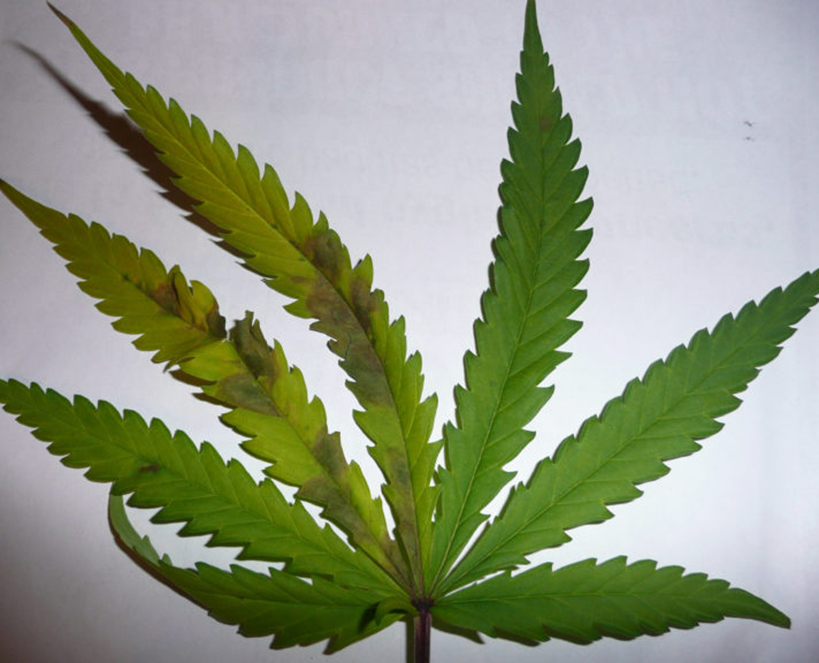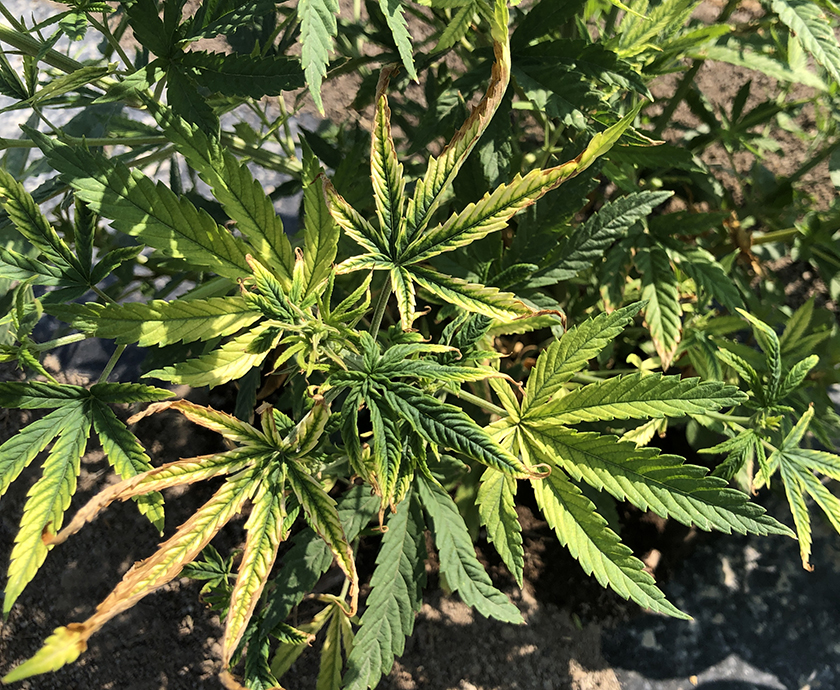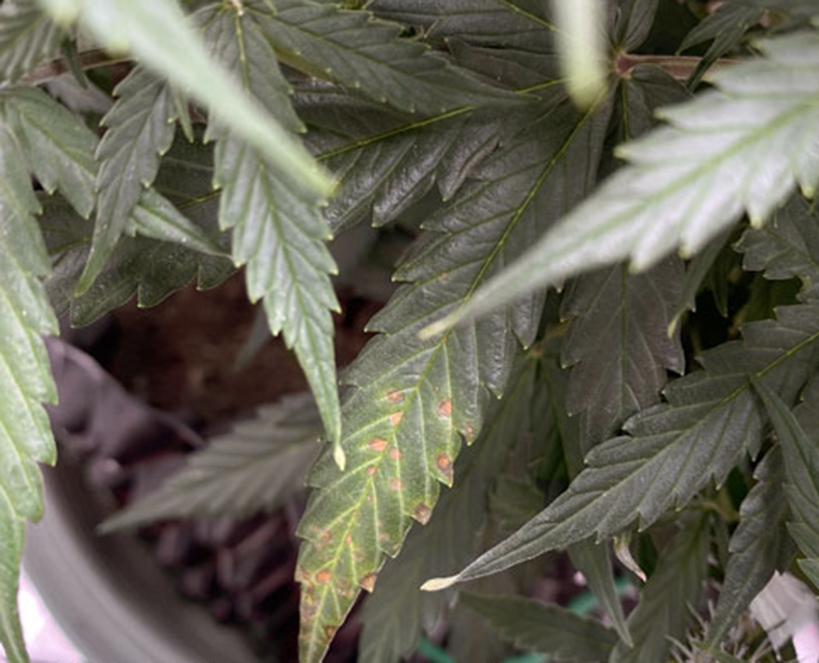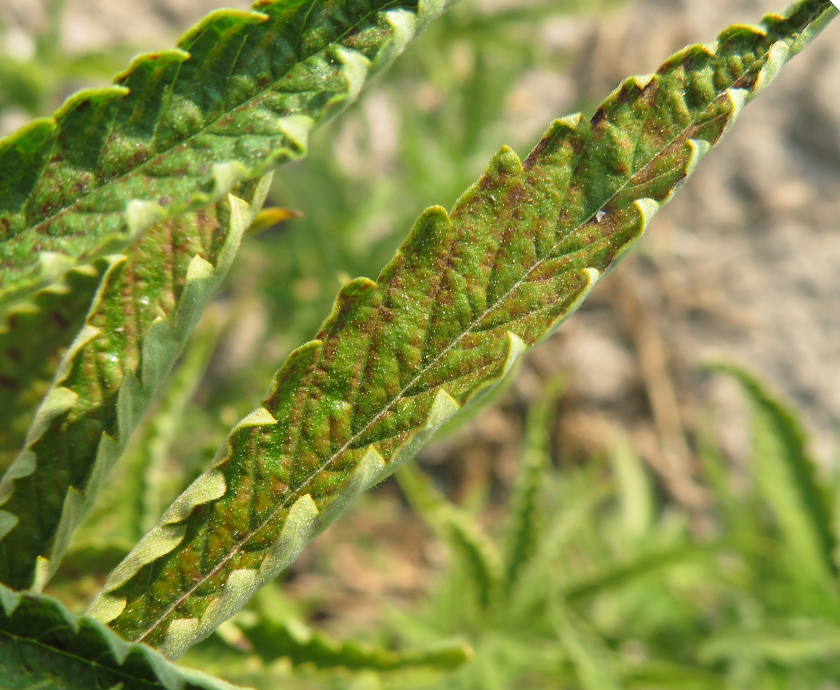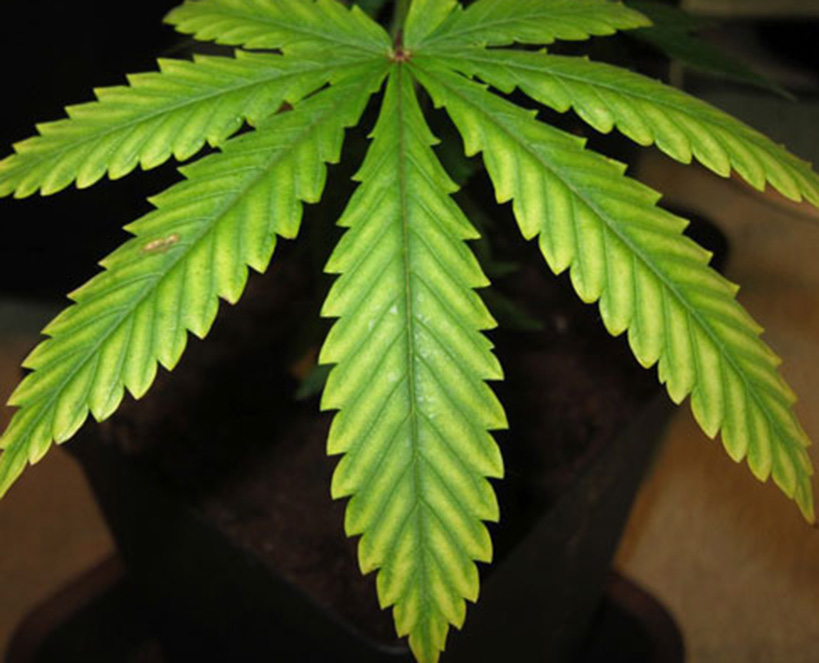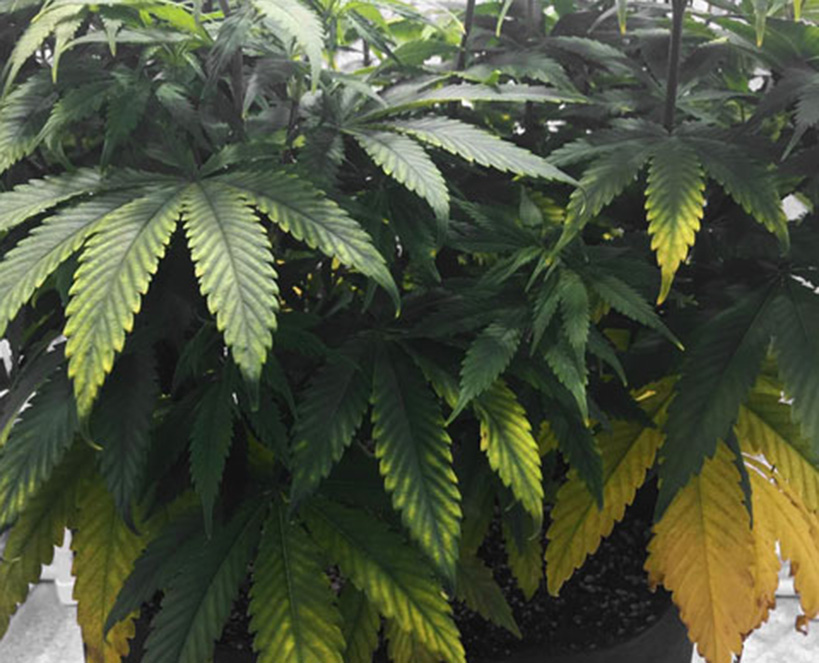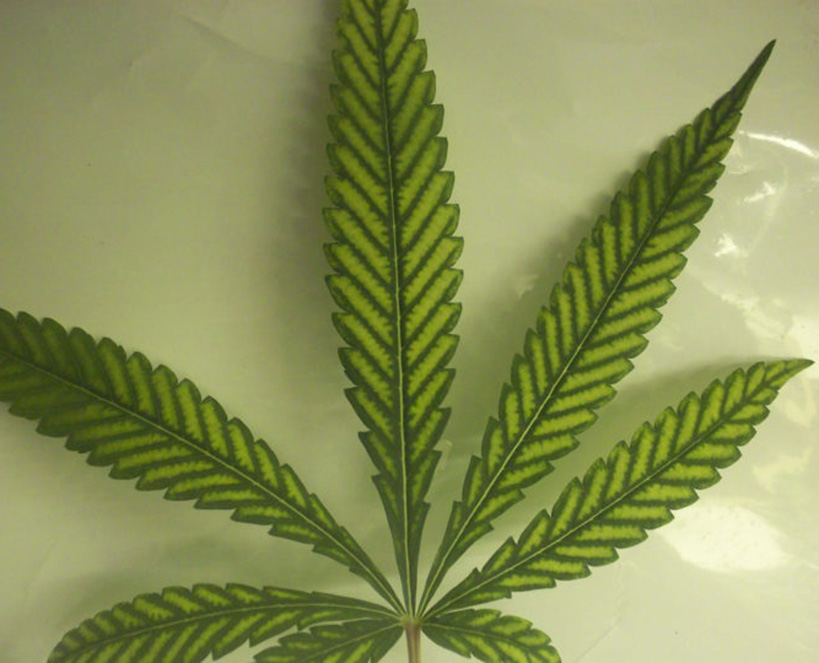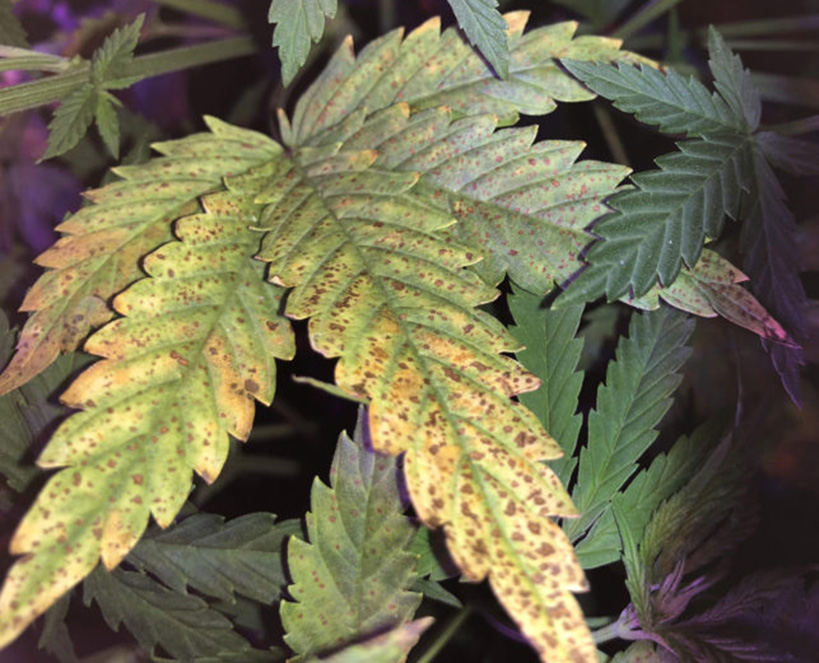Nutrient Deficiencies
Symptoms listed are based on the level of nutrient deficiency, from mild to severe.
The optimal levels of macro- and micro-nutrients for hemp CBD or fiber production may be obtained from your seed company, and much of this information is still being collected in ongoing research. For example, in CBD hemp, the production of cannabinoids may increase or decrease in various parts of the plant due to nutrient availability, and the relationship between them is dependent on several factors, including existing soil nutrient content, plant health and growth stage, and other environmental and physiological signals.
For optimal production and yield, conduct a soil nutrient test in spring to determine deficiencies and excesses and make adjustments as needed. During the summer while plants are in vegetative growth, collect foliar tissue from a random selection of plants as well as any symptomatic plants for nutrient testing and continue to make nutrient application adjustments. The Utah State University Analytical Lab, located in Logan, UT, can conduct both soil and nutrient analyses and the results will guide application of appropriate amendments.
Learn the symptoms of nutrient deficiencies and plan to monitor plants regularly throughout the growing season to prevent them from causing losses to yield.
Nitrogen (N)
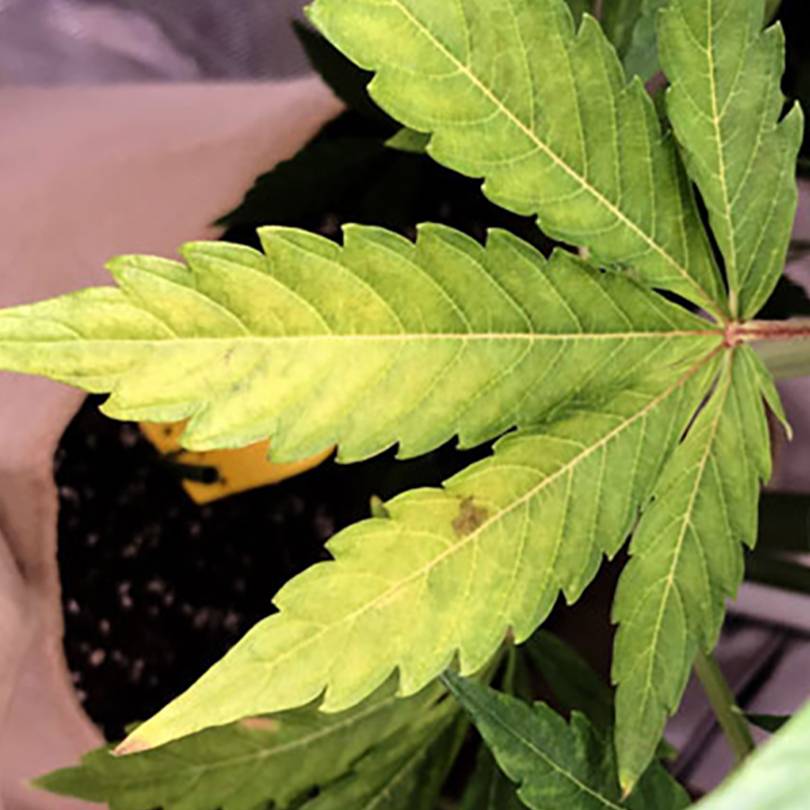 Advanced nitrogen deficiency with more severe yellowing.
Advanced nitrogen deficiency with more severe yellowing.
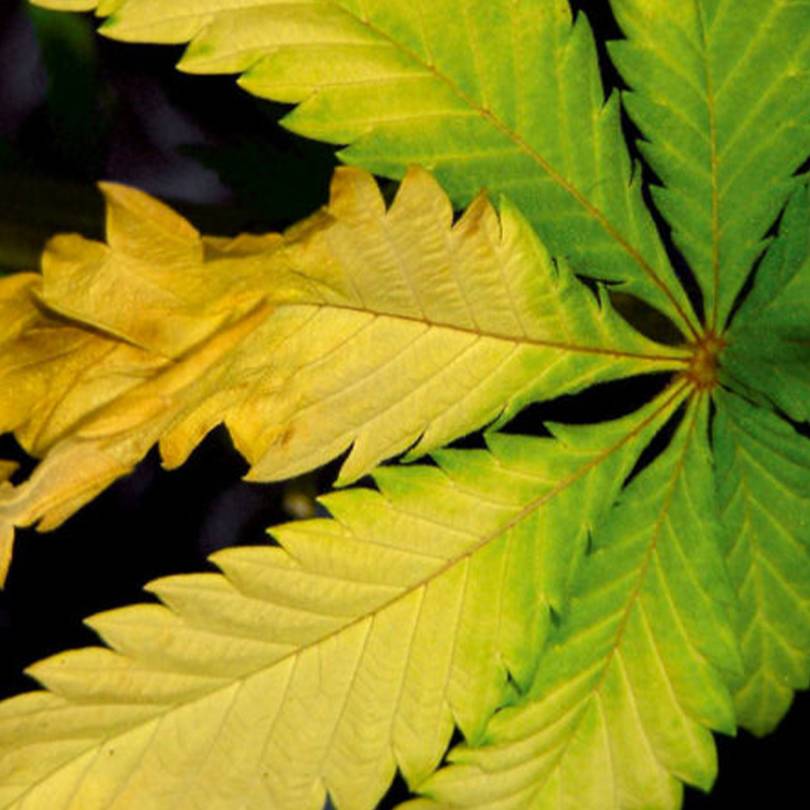 Nitrogen deficiency. Notice the chlorosis moving from the leaf tips inward.
Nitrogen deficiency. Notice the chlorosis moving from the leaf tips inward.
Importance
Nitrogen is one of the most important nutrients for hemp. It is responsible for leaf and stem growth and the overall size and vigor of the plant. Higher levels are needed during vegetative growth stages.
Symptoms of Deficiency or Excess
Nitrogen is highly soluble and easily washed from soils and therefore must be replaced regularly, especially during vegetative plant growth. Mild deficiencies can be common while roots struggle to absorb enough, but this should be alleviated when growth slows.
Deficiency
- Chlorosis (yellowing) beginning on older leaves starting at leaf tips and moving toward center
- Defoliation of extremely chlorotic older foliage
- Premature flowering
- Decreased flower and seed production
Excess
- Leaves darken beginning on lowest leaves
- Excess foliage growth
- Weak stems that are prone to breakage
- Reduced resistance to pests, especially aphids
Management
For deficiency:- Fertilize with a slightly more concentrated nutrient solution
- Enhance soil health by applying an amendment after harvest such as manure or compost, or plant a cover crop in fall and till in spring
- Where possible, leach soil with water and after leaching, apply a dilute complete fertilizer
Phosphorus (P)
 Phosphorus deficiency. Notice the purple petioles and bluish-green leaves.
Phosphorus deficiency. Notice the purple petioles and bluish-green leaves.
Importance
Phosphorus is important for photosynthesis and metabolic processes. During the hemp life cycle
young plants absorb the majority of the plant’s phosphorus needs. Most Utah soils have adequate phosphorus content.
Symptoms of Deficiency or Excess
Deficiencies tend to be common during flowering. They are more extreme in soil that is clayey, poorly drained, and soggy. High pH (>7) makes phosphorus unavailable for absorption in the soil. Cold soil temperatures can also prevent uptake. An excess of phosphorus can occur from repeated applications of manure, especially with drip irrigation that will not leach through the soil.
Deficiency
- Purple petioles
- Bluish-green leaves
- Slowed plant growth
- Dark copper or dark purple blotches on lower leaves
- Lower leaves curl downward and/or contort
- Necrosis and purple/bronze coloring on heavily affected leaves
- Small flower buds
- Delayed flowering
- Higher susceptibility to insect pests
and diseases
Excess
- Symptoms resemble nutrient deficiencies of iron and zinc
Management
For deficiency:- Apply fine, steamed bone meal and an organic source of phosphorus onto the soil before planting
- Ensure balanced levels of all nutrients because phosphorus deficiency can also be caused by excess levels of zinc and iron
- Avoid excessive applications, as leaching with water is not effective
Potassium (K)
 Potassium deficiency showing brown leaf margins, stunted growth, and curled leaves.
Potassium deficiency showing brown leaf margins, stunted growth, and curled leaves.
Importance
Potassium assists with cell division, strong root growth, and other important plant processes. It is important in plant transpiration and is responsible for the turgidity of the plant. Potassium is an important nutrient for overall plant strength.
Symptoms of Deficiency or Excess
When soil salinity is high (from excess fertilizer or sodium in the water source), potassium becomes unavailable for root absorption, causing deficiency. Cold soil temperature also causes reduced absorption. Conversely, potassium can build up in soils that have had excessive fertilizer applications. An excess of potassium is difficult to diagnose if other nutrient imbalances are also present.
Deficiency
- Rusty-brown, dehydrated, and upcurled margins and tips of young leaves
- Rust-colored blotches on foliage that turn brown
- Weak stems
- Higher susceptibility to insect and disease pests
- Slowed and diminished flowering
Excess
- May lead to deficiency of other nutrients (calcium, magnesium, zinc, iron) due to blocked absorption
Management
For deficiency:- Where possible, flood the planting rows with clean water to leach toxic
salts out of the soil - Cultivate the soil surface to improve water flow and reduce buildup of salts
- Apply a well-balanced N-P-K fertilizer with higher potassium content
Boron (B)
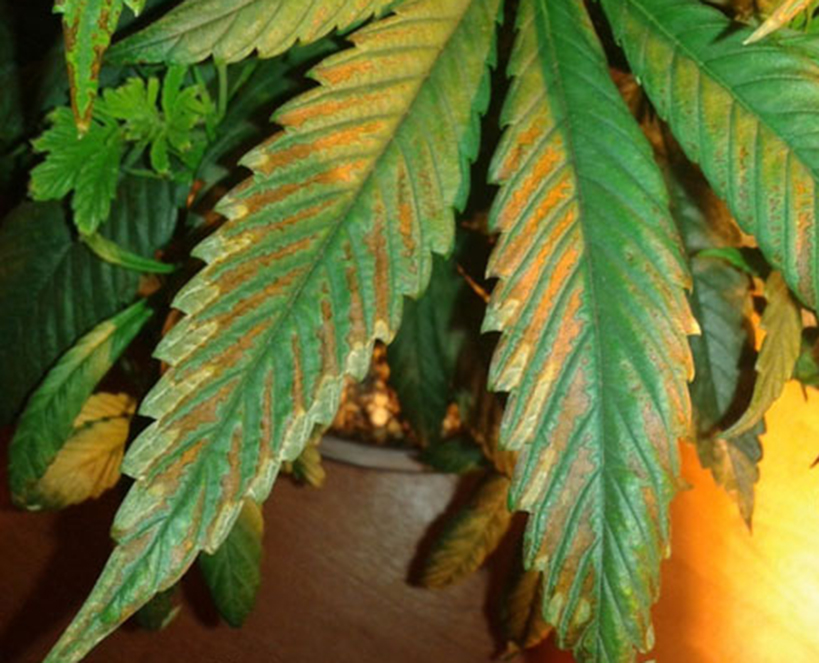 Boron deficiency. Notice the necrosis between leaf veins.
Boron deficiency. Notice the necrosis between leaf veins.
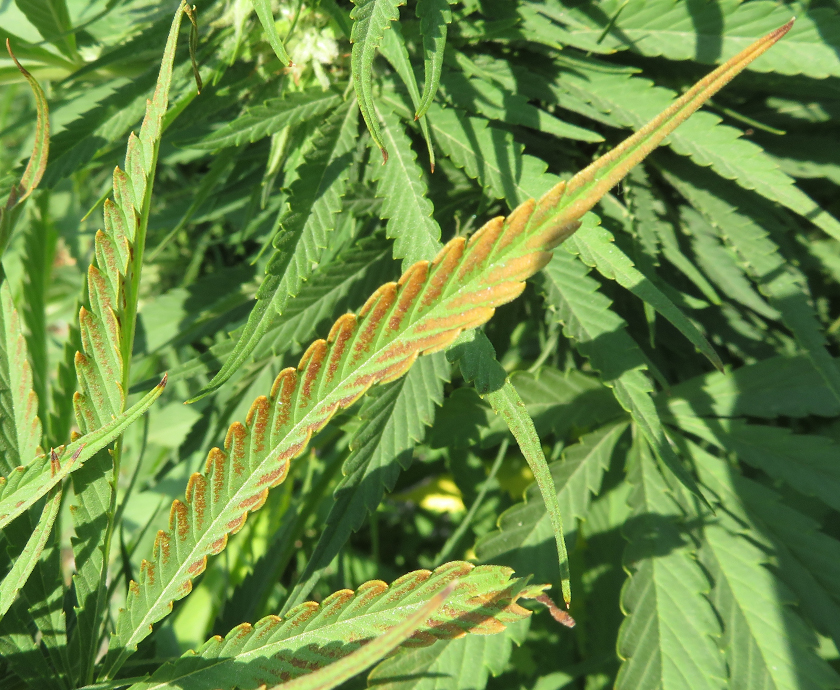
Under excess boron, older foliage is affected first with
symptoms including interveinal or marginal necrosis.

Boron deficiency. Note the stunted and twisted new tip
growth that appears burned.
Importance
Boron assists with calcium uptake and other important plant functions. It is also important in maintaining good plant structure
Symptoms of Deficiency or Excess
Boron is absent in extremely poor soils or soils that do not get fertilized. An excess
of boron is rare in nature and would only occur with over-application; it is difficult to correct before the crop is mature.
Deficiency
- Stunted, twisted, and clustered new tip growth that does not expand properly
- Growth shoots that appear burned
- Slowed root growth where root tips swell and become discolored
- Necrotic spots between leaf veins
- Thickened leaves that become brittle and distorted
- Under-developed calyxes and bracts (modified leaves) with small brown spots
- Rust-colored cork tissue on stems
- Overall droopy appearance to the plant due to lack of turgor
Excess
- Older leaves affected first
- Symptoms are similar to scorching caused by high saline soils
- Yellow leaf margins followed by
necrosis
Management
For deficiency:- Apply 1 tsp of boric acid or borax soap per gallon of water per plant or use chelated fertilizer rich in boron
- Avoid using excessive amounts of boric-acid based insecticides (for ants, for example)
Calcium (Ca)
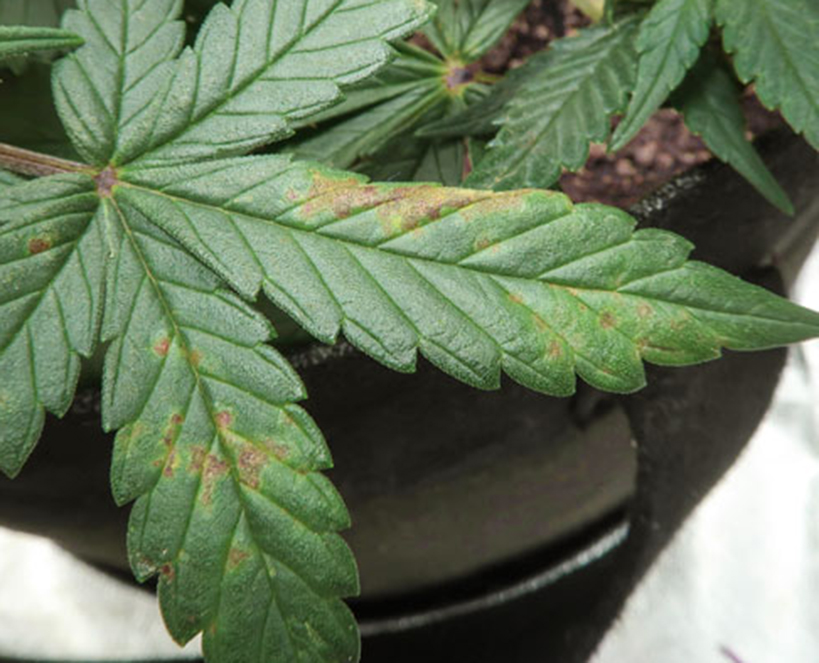 Calcium deficiency causing irregular spotting on leaves.
Calcium deficiency causing irregular spotting on leaves.
Importance
Calcium is necessary for cell formation and overall plant growth. It contributes to the overall plant structure.
Symptoms of Deficiency or Excess
Calcium deficiency may occur due to application of an imbalanced fertilizer or transport problem within the vascular tissue (caused by conditions that affect the roots such as excess water, salinity, or root damage). It is rare in Utah, and more common where soils have higher acidity.
Deficiency
- Contorted and curled lower leaves
- Yellowish-brown irregular spots on lower leaves (leaves remain green)
- Slowed flower bud development
- Root tip dieback, contributing to
overall plant decline
Excess
- Slight wilting of leaves
- Stunted growth if excessive during early plant growth stages
- Contributes to deficiencies in
potassium, iron, magnesium, or manganese and can interfere with phosphorus uptake
Management
For deficiency:- Where possible, leach soil with water to wash out any built-up fertilizer salts
that could impair uptake of calcium
- Change nutrient solution and leach root zone where possible
Iron (Fe)
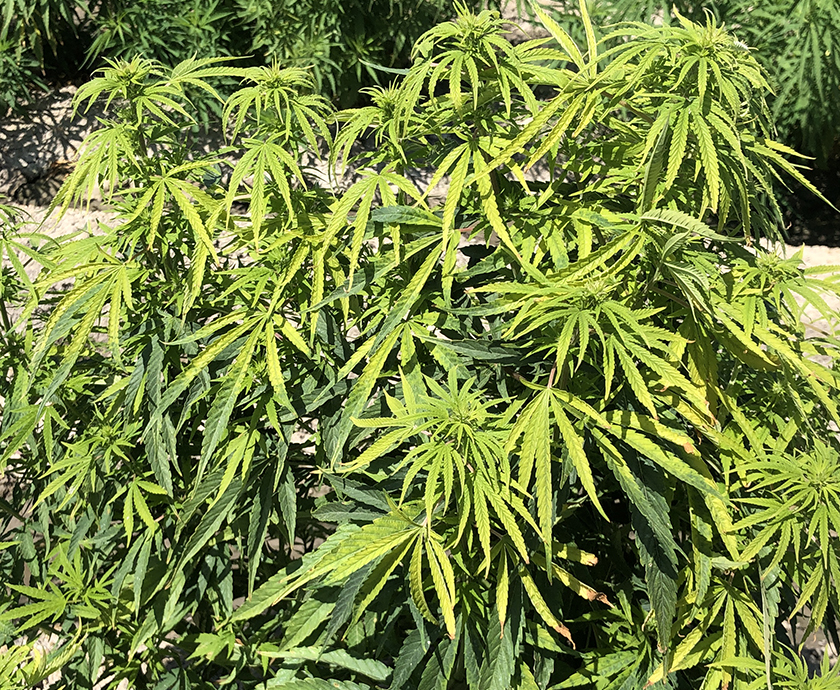 Iron deficiency showing chlorosis beginning on youngest leaves first.
Iron deficiency showing chlorosis beginning on youngest leaves first.

Iron deficiency causing advanced leaf chlorosis. Notice how the yellowing moves from the petiole out to the tip.

Bronze leaves with small black spotting caused by
excess iron.
Importance
Iron is involved in the synthesis of chlorophyll and other important enzyme functions.
Symptoms of Deficiency or Excess
Iron deficiency is the most common nutrient issue with field-grown hemp in Utah. Although iron is present in most Utah’s soils, it is not available for root absorption because high soil pH binds the iron in the soil. The problem is exacerbated by excess soil concentrations of phosphorus, manganese, zinc, and copper. In addition, excessive watering, poor soil drainage, high salt content, and cold soil temperatures prevent root uptake of iron. An excess of iron within plants would only occur due to over-application.
Deficiency
- Interveinal chlorosis beginning on young growth
- Leaf necrosis and leaf drop
- Inhibited growth and reduced yield in severe cases
Excess
- Bronze leaves with black leaf spots
Management
For deficiency:- Avoid over-irrigation, especially in heavy clay soils or when temperatures are cold
- Apply a foliar iron spray (chelated iron or ferrous sulfate) with spreadersticker for temporary results
- Apply a chelated iron compound (in the form of EDDHA in soils with a pH > 7.2) to soil before planting or via chemigation during plant growth
Magnesium (Mg)
Importance
Magnesium is important for the absorption of light energy and photosynthesis within the plant as well as many other plant processes. It is also used in metabolizing phosphorus.
Symptoms of Deficiency or Excess
Magnesium deficiency may occur if there is excess potassium or calcium in the soil or if soils are clayey, overly irrigated, acidic, and cold. Plant absorption is reduced if nighttime temperatures are below 64°F and daytime temperatures are below 75°F. An excess of magnesium is uncommon and difficult to diagnose based on visual symptoms.
Deficiency
- Interveinal chlorosis on older leaves (as opposed to iron deficiency, which appears on new growth)
- Irregular rust-brown spots on leaf margins, tips, and between veins
- Symptomatic leaves curl upward
- Sickly plant with dying and dropping leaves
Excess
- Rare and slow-acting
- Contributes to calcium deficiency and its related symptoms
Management
For deficiency:- For quick results and optimal absorption, apply magnesium sulfate as a foliar spray (2% solution of Epsom salt)
- Where possible, leach soil with water
Manganese (Mn)
Importance
Manganese is involved in essential oxidation-reduction processes and is vital to chloroplast function.
Symptoms of Deficiency or Excess
Deficiency may occur in high pH (>6.5) soils, and in soils with excess iron or a general lack of manganese. Conversely, low humidity can increase plant use of manganese due to increased transpiration. Acidic soils (low pH) which do not occur in Utah field soils, can also cause toxic uptake.
Deficiency
- Interveinal chlorosis with dark green margins on younger leaves
- Necrotic spots on severely chlorotic leaves
- Slow and stunted plant growth
Excess
- Chlorosis with dark orange-to-rusty-brown mottling on new growth
- Slow plant growth
- Loss of overall vigor
Management
For deficiency:- Where possible, leach soil and add a complete, chelated micronutrient formula
Photo Credits
- Nitrogen - Dutch Passion
- Phosphorus - Dutch Passion, USU Extension IPM Program, Sensi Seeds
- Potassium - Dutch Passion, USU Extension IPM Program, Sensi Seeds
- Boron - Dutch Passion, USU Extension IPM Program, Dutch Passion
- Calcium - Dutch Passion, Dutch Passion, USU Extension IPM Program
- Iron - USU Extension IPM Program
- Magnesium - Dutch Passion, Dutch Passion, Sensi Seeds
- Manganese - Dutch Passion, Dutch Passion, Sensi Seeds



